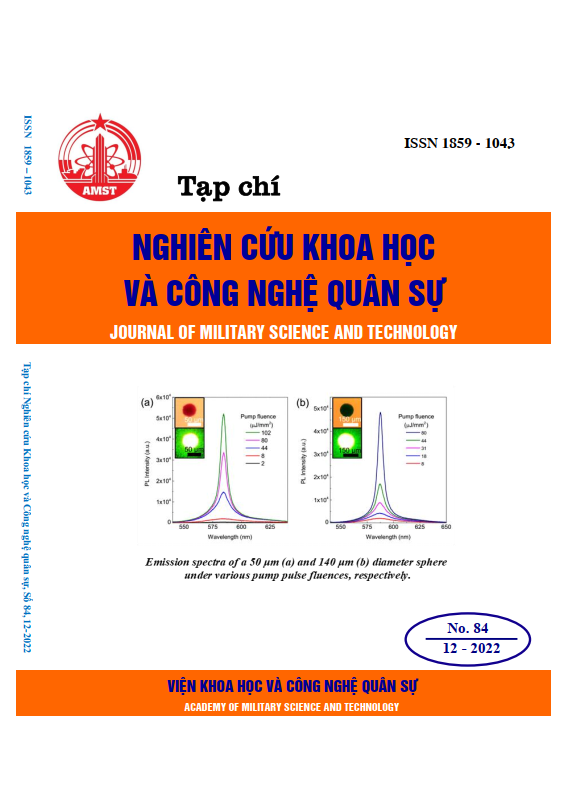Assessment of the actual state of arising and managing plastic and domestic waste in Tra Vinh using DPSIR method
1034 viewsDOI:
https://doi.org/10.54939/1859-1043.j.mst.84.2022.73-79Keywords:
Plastic waste; Domestic waste; DPSIR; Solid waste management; Tra Vinh.Abstract
In this research, DPSIR (Driving forces, Pressure, State, Impact, Response) method was chosen to assess the plastic and domestic waste situation in Tra Vinh. The data was used in this article came from both outsources and survey information, which was collected from 1,166 participants. The results showed that there is a significant relationship between the increasing ratio of plastic/domestic waste and population or gross regional domestic product per capita. The average amount of plastic waste of each person in Tra Vinh is 0.642 kg-plastic/person/day and it has a positive correlation with local people income. The pressure on environment, human health, economic and social development from plastic/domestic waste collecting and treating system in Tra Vinh were also assessed in this study. To solve the plastic/domestic waste situation in Tra Vinh, the integrated management approach has been proposed to apply. It included all following actions (1) improve policy power; (2) apply morden and suitable technology; (3) collect all of stake holders; and (4) let the local people’s support be come the community strength.
References
[1]. Ngân hàng thế giới, “Đánh giá công tác quản lý chất thải rắn sinh hoạt và chất thải công nghiệp nguy hại - Các phương án và hành động nhằm thực hiện chiến lược quốc gia,” (2018).
[2]. IUCN-EA-QUANTIS, “National Guidance for plastic pollution hotspotting and shaping action, Country report: Vietnam,” (2020).
[3]. Bộ Tài nguyên và môi trường, “Báo cáo hiện trạng môi trường quốc gia 2019 - Quản lý chất thải rắn sinh hoạt,” Hà Nội, (2020).
[4]. T. Đ. X. Huỳnh, T. D. Khổng, V. K. Huỳnh, T. T. T. Ngô, and Y. Đ. Tống, “Ứng dụng mô hình đánh giá tổng hợp DPSIR trong nghiên cứu thực trạng quản lý chất thải rắn sinh hoạt ở Đồng bằng sông Cửu Long,” Can Tho University Journal of Science, vol. 57, no. Environment and Climate change, pp. 108–120, Nov. (2021), doi: 10.22144/ctu.jsi.2021.034. DOI: https://doi.org/10.22144/ctu.jsi.2021.034
[5]. Priscilla S. Altares et al., “Elementary Statistics: A Modern Approach”, 2003rd ed. Rex Book Store, (2003).
[6]. Cục Thống kê tỉnh Trà Vinh, “Niên giám thống kê tỉnh Trà Vinh,” Trà Vinh, (2021).
[7]. Bộ tài nguyên và Môi trường, “Báo cáo hiện trạng môi trường quốc gia giai đoạn 2016-2020,” 2021. Accessed: Jul. 18, (2022). [Online]. Available: https://moit.gov.vn/upload/2005517/fck/files/20211108_Bao_cao_HTMT_2016-2020_F_a4980.pdf
[8]. L. K. Ncube, A. U. Ude, E. N. Ogunmuyiwa, R. Zulkifli, and I. N. Beas, “An Overview of Plastic Waste Generation and Management in Food Packaging Industries,” Recycling, vol. 6, no. 1, p. 12, Feb. (2021), doi: 10.3390/recycling6010012. DOI: https://doi.org/10.3390/recycling6010012
[9]. J. R. Jambeck et al., “Plastic waste inputs from land into the ocean,” Science (1979), vol. 347, no. 6223, (2015), doi: 10.1126/science.1260352. DOI: https://doi.org/10.1126/science.1260352
[10]. R. Geyer, J. R. Jambeck, and K. L. Law, “Production, use, and fate of all plastics ever made,” Sci Adv, vol. 3, no. 7, (2017), doi: 10.1126/sciadv.1700782. DOI: https://doi.org/10.1126/sciadv.1700782
[11]. Trần Thu Hương, “Nghiên cứu khảo sát hiện trạng chất thải nhựa tại Việt Nam,” (2020).
[12]. C. Díaz-Mendoza, J. Mouthon-Bello, N. L. Pérez-Herrera, and S. M. Escobar-Díaz, “Plastics and microplastics, effects on marine coastal areas: a review,” Environmental Science and Pollution Research, vol. 27, no. 32. Springer Science and Business Media Deutschland GmbH, pp. 39913–39922, Nov. 01, (2020). doi: 10.1007/s11356-020-10394-y. DOI: https://doi.org/10.1007/s11356-020-10394-y
[13]. N. J. Beaumont et al., “Global ecological, social and economic impacts of marine plastic,” Mar Pollut Bull, vol. 142, pp. 189–195, (2019), doi: 10.1016/j.marpolbul.2019.03.022. DOI: https://doi.org/10.1016/j.marpolbul.2019.03.022
[14]. D. S. Nguyễn, “Quản lý tổng hợp chất thải rắn - Vấn đề và giải pháp chính sách ở nước ta”. Viện Phát triển bền vững vùng Bắc Bộ, (2010).







